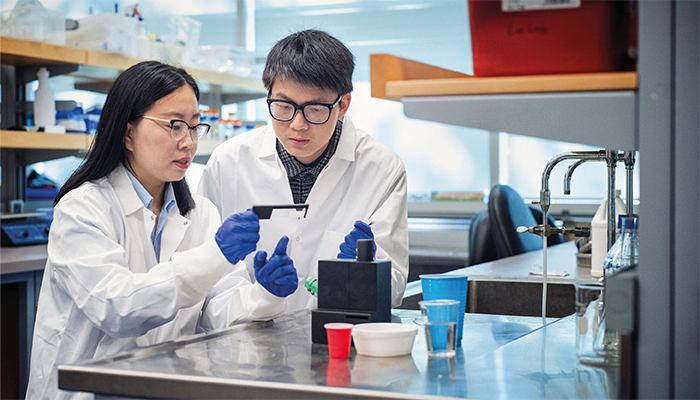
Credit: Martin Dee
A low-cost, portable device developed by University of British Columbia researchers can quickly detect micro- and nanoplastics released from everyday items, such as disposable cups and water bottles. The tool uses luminescent metal-phenolic networks (L-MPNs) to fluorescently label and identify plastic particles as small as 50 nanometers, providing rapid results with minimal sample preparation.
L-MPNs, made from zirconium ions, tannic acid, and rhodamine B, enhance the fluorescence of microplastics, allowing the particles to glow under a green LED light in the device’s integrated microscope – enclosed in a biodegradable 3D-printed box. The wireless digital microscope is connected to a smartphone app powered by customized MATLAB software that uses machine-learning algorithms. By capturing and analyzing images of plastic particles, the device is able to “count” the plastics in the sample.
In the study, the device successfully identified microplastics released from disposable polystyrene cups after exposure to hot water. The study found that these cups released millions of nanoplastic particles, highlighting the potential for everyday items to contribute to microplastic pollution. The device operates with less than a drop of liquid sample and delivers results in minutes, making it suitable for both laboratory and field applications.
Each test costs about 1.5 cents, and the device’s portability means it can be used in various settings, from food processing labs to environmental monitoring stations.
“My team aimed to create an accessible, low-cost detection tool that could be used by anyone, from scientists to everyday consumers, to identify microplastics and nanoplastics in liquids,” says Tianxi Yang, an assistant professor in the faculty of land and food systems, and corresponding author of the study.
“One of the biggest challenges during the research was simplifying the complex process of microplastic detection, which traditionally requires expensive equipment and skilled personnel, such as using transmission electron microscopy (TEM),” says Yang. “TEM also can not achieve quantification. In contrast, our new device, although slightly less accurate regarding the size and shapes of plastic particles than TEM, achieves impressive results by using a wireless digital microscope, LED light, and machine-learning algorithms to identify plastic particles with ease, portability, and affordability.”
“The technology could be employed in various sectors, including food processing labs, environmental monitoring, and even household use,” says Yang. “We currently do not see challenges to commercializing devices that detect all single types of particles in water. However, challenges remain regarding adapting it to detect plastic particles in a complex matrix, such as soil.”
The next steps for the researchers include commercializing the device. They also plan to adapt the device's algorithms to detect different types of plastics, such as polyethylene and polypropylene, broadening its applicability for various materials and environments.
“We hope to push towards commercial applications that could help reduce the global health and environmental impacts of plastic pollution,” says Yang.



